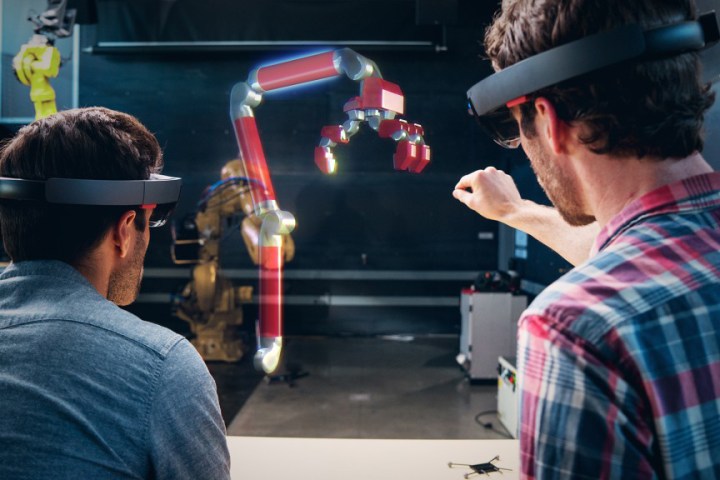
The rise of HMDs won’t just bring with it better screens, improved wireless transmission, and advanced graphics. It will also bring about a culture shift, where computers aren’t just boxes under desks, or even the sleek 2-in-1s on the bleeding edge now.
Glassholes paved the way
While Google’s experimental adventure into eye-mounted displays had problems of its own, it also forced people to ask important questions about wearable tech. Where is appropriate to wear it? When does it need to come off? Should it be equipped with cameras? Can we make porn with it?
While most of these questions haven’t been answered firmly, the point is that people are asking them. It’s a wild, radical time in the computing, akin to the jump from the physical punch cards used by the first computers, to the electronic and magnetic memory used today.
Hate them or love them, glassholes were the ones who first brought HMDs into malls, bars, movie theaters, and town squares, ringing the bells of new technology. Best of all, they did it early, before anyone thought it was okay, and paved the way for devices like the Google Cardboard and Samsung GearVR.
Share the love
Nothing defines the 2015 mindset on HMDs like the GearVR. It’s not an augmented reality set, but it has all the trappings of one. That includes a camera with a pass-through mode, a feature I firmly believe is just around the corner from general use in a large number of apps.

It’s also solves one of the major problems with VR and AR – that the experience lacks value until you actually try it. More than once I’ve handed a Gear over to a VR newbie, only to have to pry it away from them later. Seeing it for yourself makes the experience real, and that person doesn’t make fun of other people in the headset. They want to share in it instead.
These projects aren’t a gimmick anymore, and it’s starting to show.
Microsoft’s burden
Microsoft is making a solid decision pricing the HoloLens out of reach of consumers. It’s not a device with software support or existing applications outside of a few tech demos. It needs to be fleshed out by developers and vetted thoroughly before it can operate consistently in an office or home.
First wave development kits usually happen out of the public eye, but with the massive hype building around the device, there was no way for Microsoft to keep it under wraps. And maybe that’s for the best. Microsoft has a long history of abandoning projects halfway through, and pressure from the community will keep it honest. It’s also a reminder that this project isn’t just a pipedream, but is in the hands of developers, who are actively working to bring their software to the platform.
It may be the most advanced example of augmented reality out in the real world at the moment, but the technology for the next wave is already in development, and may be on your next tablet.
Good Intel-tions
When Intel starts working on a project in earnest, that’s when it’s time to start really paying attention. The massive chip maker swings it weight around and takes the computing world with it. We saw it with the rapid proliferation of Compute Stick clones, and we’re seeing it now with the RealSense cameras that are enabling advanced biometric login. And that’s not all those cameras are being used for.
In fact, what was first regarded as glorified webcam technology has become a crucial piece of the augmented reality puzzle. The world around us is unpredictable at best, and RealSense cameras are able to understand depth and distance, allowing computers to make sense of the way we move and interact with objects.

It’s also important to remember that Intel doesn’t just set the example, it builds the chips that power it. Mobile devices may make use of Qualcomm or even Rockchip options, but Intel will lead the charge for the next few years, as it’s always done.
Meta
It isn’t just behemoths like Intel and Microsoft working on this technology, however. A small team just announced the Meta 2 developer kit for a Q3 2016 ship date, and the device is nothing short of impressive on paper. It boasts a massive 90 degree field of view, just short of modern VR headsets, with high-quality 1440p projections.

But the Meta’s importance doesn’t come from the impressive hardware, it comes from the fact that the team was able to produce it at all. The headset is concrete proof that AR isn’t just a pursuit of the biggest companies in the world, a sure sign the technology is on its way to the mainstream.
Strap in
There’s a lot to look forward to in a world drive by HMDs. Individual system customization, infinite displays, completely immersive gaming and media — but it’s not all sunshine and roses.
The idea of a screen two inches in front of everyone’s’ eyes at all times isn’t just distracting, it flies in the face of the very reason we gather to work in offices in the first place. It’s only a matter of time before that reaches our personal lives too. If you think a first date that spends all their time iPhone is annoying, what about one with a HoloLens strapped to their face?
I’m getting distracted. The point is, this technology is right around the corner, like it or not. In a few years time, an HMD on a friend’s face will be as half as common as the iPhone, twice as annoying, and ten times as efficient.


